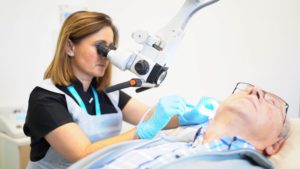Microsuction is considered to be safer and more effective compared to ear syringing, as it avoids touching the sensitive skin of the ear canal and will have no contact with the ear drum. This means that the risk of infection is reduced. When your hearing is concerned, it is important that you find the ear cleaning method that is right for you. So, what is the difference between microsuction and ear syringing, and which one should you choose for your treatment?
What are the options for clearing excess earwax?
According to the National Institute of Health and Care Excellence (NICE), there are four routes to clearing impacted ear wax, otherwise known as ear wax blockage. These are the following:
- ‘Watch and wait’
- Cerumenolytic agents (sodium bicarbonate, olive oil, almond oil, water/saline)
- Irrigation
- Manual removal
Often the use of cerumenolytics is combined with either irrigation (ear syringing) or manual removal (microsuction) to soften the wax. The first two methods are suitable for less severe blockages, whereas irrigation and manual removal are more suitable for severe cases.

What is ear syringing?
Ear syringing, or ear irrigation, is a process that is sometimes performed on the NHS to remove ear wax blockages. Many pharmacies also offer over-the-counter ear syringing kits for home use. Water is pumped into the ear canal using a specialised low pressure tool, softening and loosening any wax present. It is typically a procedure that takes fifteen minutes to half an hour. As the water runs back out of the ear, a cup or basin is placed under the ear to collect it and any ear wax it has flushed out. Patients sometimes report minor discomfort from the sensation of water touching their ear drum.
Prior to ear syringing, the ear wax needs to be softened using ear drops. These can be clinical drops such as those containing hydrogen peroxide, or other lubricating fluids such as olive oil. This softening process can take several days to a week (sometimes longer) beforehand.
What are the risks from ear syringing?
Water in the ear is a key cause of ear infections, or otitis. When water sits in the ear canal, it provides a moist environment for bacteria or fungi to grow. This is why ear infections are commonly referred to as ‘swimmer’s ear’ due to the increased likelihood of waterlogged ears after spending time in the pool. If you have any of the following symptoms, you may have an ear infection, so consult your GP.
- Redness or scaling on the inside of your ear
- An itching or burning sensation in or around your ear
- Discomfort or pain in your ear, or a feeling of pressure
- Clear, odourless discharge that drains from your ear canal
- Sudden hearing loss
Research suggests that the risks from ear syringing are exacerbated with age. Hearing loss due to wax build-up can increase as we get older, due to the glands in your ears (cerumen) that produce ear wax becoming drier. This means that ear syringing is often not the best solution for all patients.

How is microsuction different from ear syringing?
Both methods of ear wax removal can show positive results, but preliminary evidence suggests that microsuction offers fewer risks, particularly for patients who have existing ear conditions (Source: British Journal of Clinical Pharmacology). At Wellbeing, our clinicians use ENT surgical binocular microscopes to magnify their view of the ear canal and pinpoint the wax deposits to be removed. This precision means that Microsuction can be used even when the patient has had an ear infection or a perforated ear drum. The gentle suction of the tool ensures that you experience minimal discomfort during the process.
With Wellbeing, our audiologists are all trained in microsuction. Healthcare practitioners cannot offer microsuction as a service unless they have received specialist training with the equipment, whereas ear syringing does not require specific training. As a ‘dry’ procedure, water is not introduced into the ear with microsuction. Throughout your microsuction appointment, a sterilised speculum is used to keep the ear canal open, which means that there is no contact between the microsuction tool and the skin of the ear canal or ear drum. This significantly reduces the risk of infection.
Are there any side effects from microsuction?
Any side effects following microsuction can be reduced by using ear drops before the procedure to lubricate the ear canal. Patients sometimes report dizziness following microsuction. The dizziness can be alleviated by sitting up slowly following the treatment. Other side effects, such as slight hearing reduction immediately following the procedure, are minor and short-lived. The environment at Wellbeing clinics is designed to put patients at ease, and to encourage you to relax during treatment. Our friendly audiologists will answer any questions you may have prior to the treatment beginning.
Are you interested in how microsuction can help you? Book a microsuction appointment at one of our clinics in Halstead, Braintree, Chelmsford, Colchester, or South Woodham Ferrers using our online system, or visit our contact page to get in touch and discuss your treatment with one of our Patient Care Advisors.
